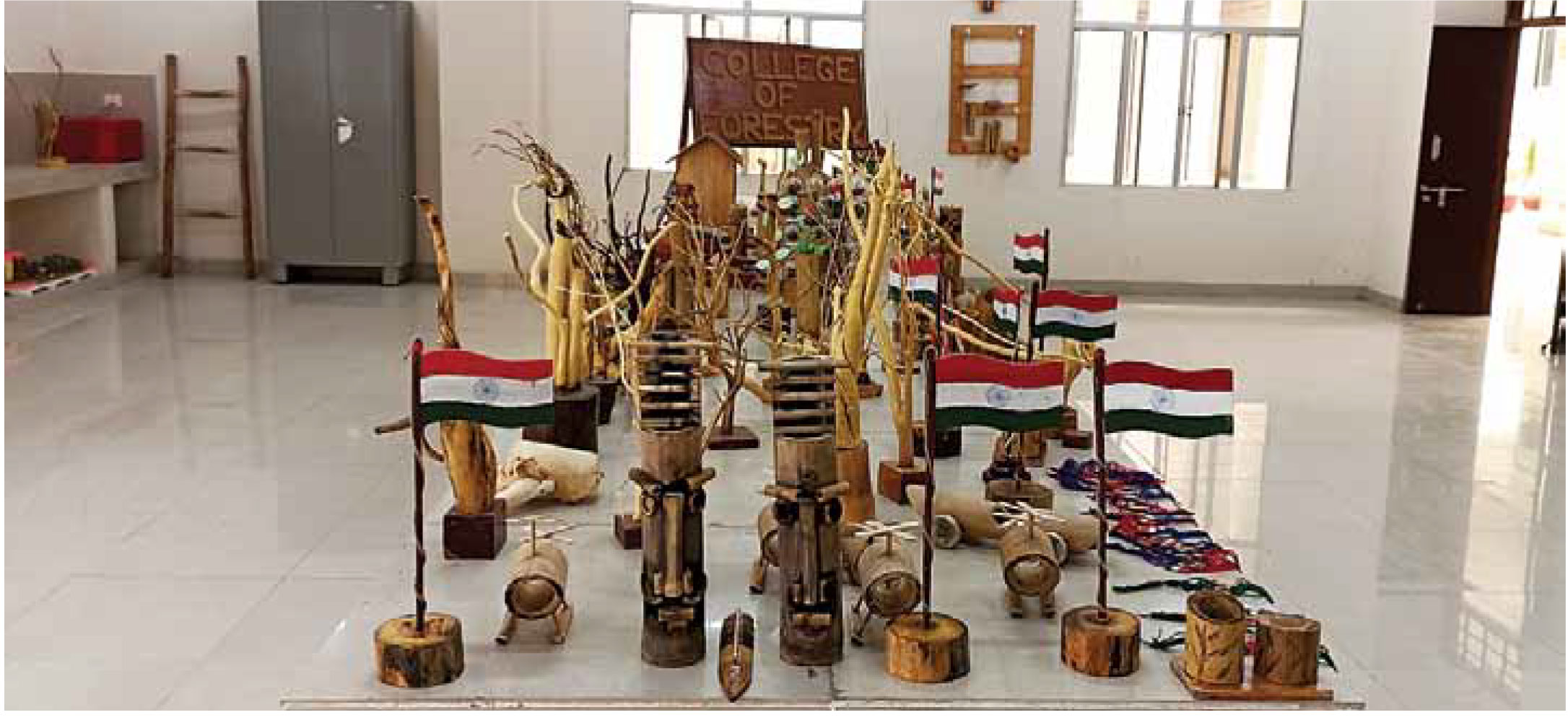
Bamboo based products for an eco-friendly environment
By Dr. Yogesh Y. Sumthane
Bamboo a versatile multipurpose produce, play a vital role in the economic development of poor people of Developing countries. More than 7000 ways of bamboo use have been listed and more are coming day by day. Bamboos are important from the birth to death in our social life. From many more years our indigenous people practice like the use of bamboo in the severance of the umbilical cord of new born and for circumcision (sharp edge of freshly cut bamboo) are there since steel knives or blades are suspected to cause infection. Bamboos are used from “cradle to the coffin” of the North-eastern hill people. Bamboos are treated “Green Gold” to the Bamboo growers.
Every year, billons of plastic objects end up in our seas and landfills. It’s a major issue.Small daily behaviours such as brushing your teeth, sipping with a straw, and dining with forks and throwaway plastic spoons can have a significant influence on our natural system. We must to know that the typical individual discards four plastic toothbrushes every year? A lot of plastic pollutes our environment unnecessarily. Why not make a simple, inexpensive option that can truly make a difference?
You may help the environment by decorating your home with the most eco-friendly and sustainable bamboo.
Bamboo is frequently referred to as one of the most environmentally friendly materials currently available on the market, but what exactly does this mean? The bamboo toothbrush is regarded as the most incredible green alternative to the regular plastic toothbrush since it provides several advantages to both the environment and health.
Bamboo is utilized as a raw material for environmentally friendly, soft, antibacterial and absorbent fibers used in the production of textiles. This level of softness and absorbency outperforms cotton, resulting in an outstanding towel fabric. Bamboo materials are antifungal, breathable, hypoallergenic and thermochromics, and if you have ever wondered how sustainable bamboo fabric is–you wouldn’t believe it! These advantages enable us to produce items such as towels, sheets and blankets that are good for the health of new-borns and adults.
Textile items such as bedding, underwear, fashion accessories, and so on exist and may be manufactured.
The bamboo plant is particularly valuable in a building because its main stem may be utilized to build different types of structures. This stem is constructed of robust wood that is very flexible. It is a good material for house construction.
Bamboo can also be used to make scaffolding, roofs, walls, pillars and other construction-related structures.
Bamboo is a sustainable material with several technological advantages. It is as safe as iron or steel and as a corrosion and moisture resistant insulator.
Using the plant’s stem and tiny fibers, bamboo may be fashioned into a variety of things. You may produce everything from handicrafts to personal products, including domestic utensils, with this basic material.

Bamboo may be handled in the same way as wood is. This material is ideal for creating various patterns or ornamental endeavours. It may be used to create furniture, materials, toys, baskets and domestic items, among other things.
A variety of Bamboo products are widely available on the market. Curtains, coverings, pillows, picture frames, vases, plates and silverware among other household furnishings are widely available.
Many additional products are being developed or will be developed using bamboo as a raw material. The initiative of the usage of Bamboo is also influencing music. These materials robust and lightweight properties are employed in the manufacture of musical instruments. It is used to make flutes and drums. Bamboo is used in sports and recreation to produce bicycle, surfboards, bats, and other products. Bamboo is also increasingly being used in kitchen equipment.
Cutting boards, crockery, cutlery and spoons look great when made of this material. Maximum utilization of this miraculous grass towards plastic replacement. With 3R’s Reuse, Reproduce and Recycle. In rural sector people use bamboo for walling of huts, thatching and roofing, construction, walking sticks, basket making, bows and arrows, cooking utensils, mats, water and milk vessels, cups, hedges, fuel, furniture, agricultural and horticultural implements, tools handles, fodder, fencing, smoking pipes, fishing rods, fish traps, pipes for water supply, wild animals and bird traps, grain storage structures, hay stack stabilizers, cradles, scaffolding, cart yokes and bodies, ladders, sieves for cleaning grains, agarbatti sticks, stakes for planting, tiles, tent poles, pan trays, trays for rearing silk worm, seed and fertilizer drills, roof and floor of boats, ornaments, culm sheaths for irrigation, plaited shoes, masts of boats, bridges, for medicinal purpose (Bambusa vulgaris for treatment of jaundice). Bamboo can play a positive role in afforestation, environmental up gradation and socio-economic development of the poor hill people.
Uses for Environmental Restoration
- Timber Substitut
- All Soil and Season
- Soil conservation
- Neutralization of acid soil
- Reduction of siltation of rivers and reservoirs
- Reducing global warming and in mitigation its impact
- Renewable source of energy
- Biodiversity conservation
- Increasing soil fertility and stabilizing the earth
- High bio-mass production (30-50 MT per hectare)
- High carbon absorption potential
- Bamboo can provide fast vegetative cover to deforested areas
Species wise uses of Bamboo
- Meloeanna baecifera :- Housing, thatching, roofing, symbol of God, Pulp and paper mills, agarbatti sticks, mats, wall panels, fencing, bag handles, umbrella handles, ice-cream sticks, shade for betel leaf cultivation, edible shoot etc.
- Bambusa tulda :- Housing, fenc ing, poles, symbol of God, trusses, toys, mats, wall panels, handicrafts, agarbatti sticks, edible shoots etc.
- Bambusa balcooa :- Housing, structural applications, poles, trusses, tool handles, rickshaw hood frame, scaffolding, mats, reinforcement for mud walls and roads, platform of carts, boats, bridges etc.
- Bambusa vulgaris :- Housing, structural applications, agarbatti sticks, poles, trusses, fencing posts, paper pulp, mats, reinforcement for mud walls and roads, platform of carts, boats, bridges, etc.
- Dendrocalamus strictus :- Structural applications, sticks, poles, paper pulp etc.
Why Bamboo?
Timber wood takes about twenty and sixty years to mature and harvested, in the other hand bamboo takes a very short time to regenerate in comparison. Most species of Bamboo that are used in architecture can be harvested after three to six years of growth. The quickest growing species of Bamboo can grow up half meter a day, and reach full growth within two months’ time. This makes bamboo the most efficient renewable resource.



